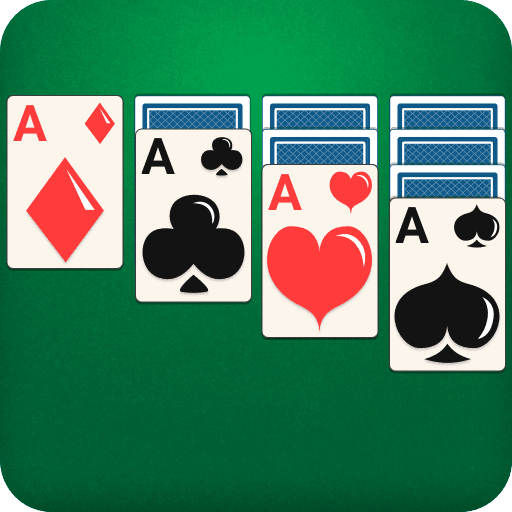The most popular 6 types of Solitaire games

The term Solitaire is often wrongly used to refer to a specific kind of card game known as Klondike or Patience in the UK. In reality, there are several types of Solitaire games.
Klondike is still the most popular version of the game. After all, it was the first to trigger the massive popularity of this type of card games after its inclusion in Microsoft’s software in the early 90s. However, several other versions are now competing for that top spot.
The most popular types of Solitaire games share many similarities, especially because they are all designed to be played by only one player (thus the term Solitaire). Nevertheless, their tiny differences make them unique and challenging on their own accord.
1. Klondike

Klondike is the most popular version of Solitaire. So much so, that when used alone the term “Solitaire” usually refers to this game. Its origins are uncertain, but it is likely to have first appeared during the gold rush, in the 19th century, in the region of Klondike in Canada, from where it derives its name.
Its massive popularity can be traced back to its inclusion in Microsoft’s Windows 3.0 in 1990.
Game-play
Klondike uses a 52-card deck. The goal is to arrange them by suit, starting with the Ace and ending with the King, on empty areas called the foundations.
The cards are dealt into 7 piles on the tableau (the game area). All the cards are facing down, except for the upper one in each pile. To access and reveal the bottom cards, the players have to build sequences and move them within the piles. Sequences on the tableau are built in descending order (from King to Ace) and with alternating colors. Only Kings can be moved into empty spaces on the tableau.
The remaining cards that were not dealt into the piles are arranged in a Stock pile. These can be called into play to help players build their sequences.
2. Spider
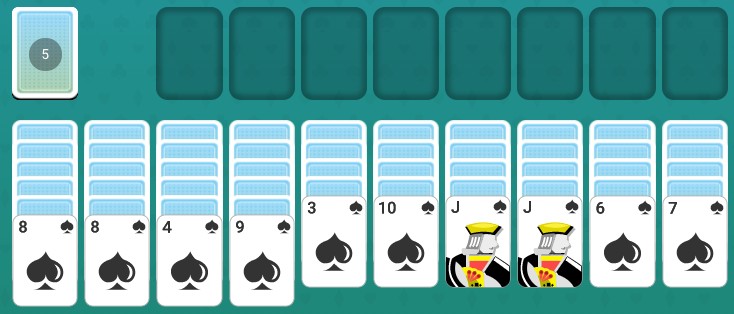
Although Klondike is the most popular version in general, Spider Solitaire takes the top spot within the 2-deck types of Solitaire games. It takes its name from the 8 foundations that must be built to win the game, as spiders normally have 8 legs themselves.
The chances of winning a Solitaire Spider game are said to be around 1 in every 3 games.
Game-play
Solitaire Spider uses two card decks. Depending on the difficulty level, it can be played with one or more suits. The tableau setting is generally similar to that of the Klondike, with piles, a Stock pile, and foundations. However, the cards are all exposed and only full sequences can be sent to the foundations.
The goal is to build suit sequences within the piles, starting with the King and ending with the Ace. The game becomes considerably more challenging if more than one suit is used.
Tapping on the Stock pile will add an extra card to every pile.
3. FreeCell
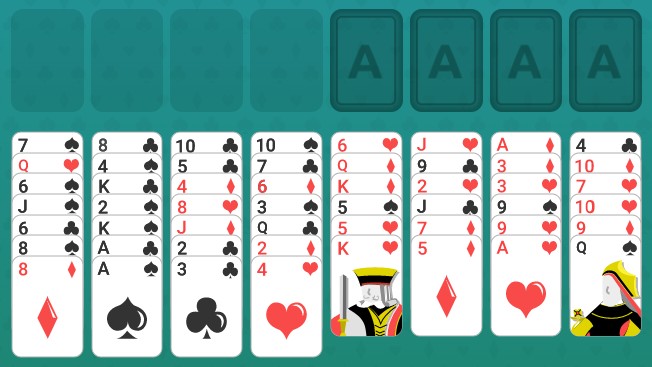
Out of the different types of Solitaire games, FreeCell Solitaire is the one that resembles Klondike (the regular version) the most. However, it is considered a more strategic version of the latter, as it requires a more careful and thoughtful approach.
Nevertheless, it is one of the Solitaire games with the highest solvable probabilities. Around 99% of its deals are estimated to be solvable.
Game-play
FreeCell’s game-play is the most similar to that of Klondike. It also uses one single deck, and the cards are dealt into 7 piles. In this Solitaire game, however, all cards are dealt and there is no Stock pile. The cards are also facing forward and visible to the player. The goal is to build the foundations by suit.
Sequences are also built in the same way as with Klondike: by suit, in ascending order in the foundations, and in descending order, with alternating colors within the piles on the tableau.
The main difference between them is, nevertheless, the existence of 4 empty spaces on the tableau: the free cells. Cards can be sent to these cells and be left on hold, to free those underneath them.
Once a card is in a free cell, it can only be called into play again to build a pile or foundation sequence. It is not possible to exchange cards.
4. Tripeaks
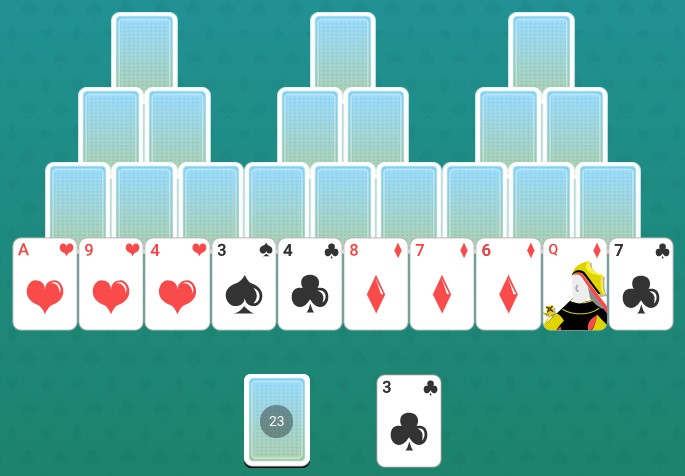
Tripeaks derives its name from the three pyramid peaks formed by the cards’ display on the tableau. It is also known as Three Peaks, Tri Towers, and Triple Peaks.
The game was invented by Robert Hogue in 1989. Hogue ran a computer statistical analysis on its original creation and concluded that approximately over 90% of all Tripeaks games are winnable.
Game-play
This game uses a 52-card deck. The cards are positioned in the shape of three 4-rows pyramids. The base of each pyramid contains 4 cards facing forwards, while the others are facing down. The remaining cards are set in a Stock pile.
The goal of the game is to clear all the cards from the tableau. To do so, the player must deconstruct the pyramids by building sequences of cards 1 point higher or lower than the previous one, regardless of suit. For instance, a 4 can build a sequence with a 3 or a 5, and so on.
The cards that are removed from the pyramid are sent into a discard pile. The top card of this pile becomes the base for the next sequence. When there are no more moves available, the player may use the Stock pile and send a different card to the discard pile to be used as the sequence base.
5. Pyramid
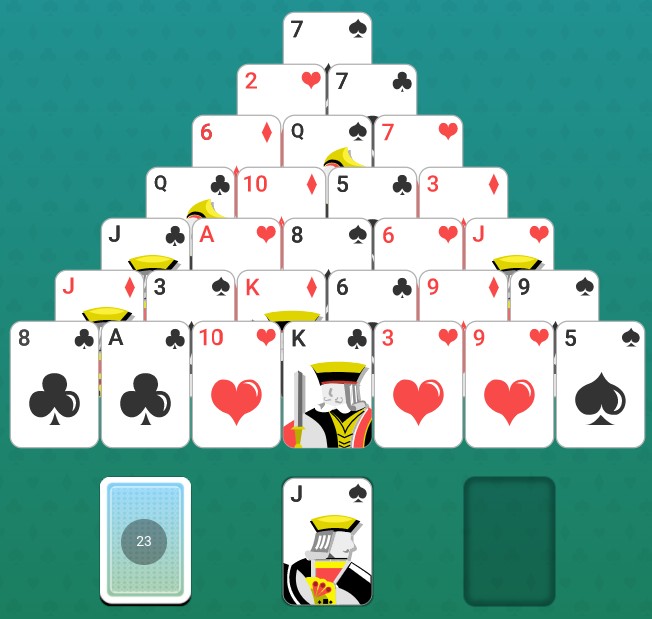
Pyramid Solitaire gets its name from the single pyramid shape of the dealt cards on the tableau. Despite its simple layout and rules, it is one of the types of Solitaire games with the lowest probability of winning.
Victory in this game is conditioned by the different ways that cards may be positioned on the tableau and by the strategic approach taken by the player. When the rules are set to allow the player to only go through the Stock pile once, the chances of winning are around 1 in 50.
Game-play
Pyramid is a Solitaire pairing game. 28 cards are set on the tableau, all facing forwards, in the shape of a pyramid. Only the cards that are not covered can be called into play.
The goal is to deconstruct the pyramid by pairing cards whose total equals 13 points, regardless of their suit (e.g., 8+5=13). When using a standard 52-card deck, the King is valued at 13 and can be removed by itself. The Queens are valued at 12 and the Jacks at 11.
The player can draw one card at a time from the Stock pile to try to find a match for a card on the pyramid. The difficulty of the game is set depending on the number of times a player may go through the Stock pile.
6. Yukon
Yukon Solitaire is a game heavily inspired by the traditional Klondike and, yet, its rules are significantly different to make it a completely independent game with a higher difficulty level.
The goal in the Yukon Solitaire is also to build four foundations by suit, starting with the ace and ending with the king. However, the rules to move the cards around the tableau are a bit more challenging, especially because of the inexistence of a Stock pile or any type of help.
Game-play
A 52-card deck is set on the tableau, divided into 7 piles. All cards are exposed, except for the bottom ones, ranging from 1 to 6, starting from the left. There is no Stock pile.
The sequences within the piles are formed in the same way as in the Klondike game, that is, in descending order and alternating colors. However, the cards do not need to be in a sequence or free to be moved around. The only rule is that they can only top free cards. The goal is to move around the cards and expose the suitable ones to build ascending sequences by suit on the foundations.
Other popular types of Solitaire games
There is an incredible number of types of Solitaire games, without even counting the different variations within each game. The previously listed five stand out clearly as the most searched and played Solitaire games, but many others are gaining track in recent years.
Baker’s Dozen
This game uses a standard 52-card deck. The cards are set into 13 piles (a baker’s dozen), all facing forward. The Kings are always placed at the bottom of the piles.
The goal is to build the foundations in ascending order (Ace to King). Only the upper cards can be moved within the piles. It is not possible to move sequences within them. The suit does not matter to build sequences in the tableau.
Forty Thieves
Forty Thieves is played with two 52-card decks. The cards are dealt into 10 piles with 4 cards each (the 40 thieves that stand in the way of winning). All cards are exposed.
There are 8 foundations on the tableau where the player must build suit sequences in ascending order.
Sequences within the piles must be in descending order and of the same suit. The player can only move one card at a time. It is not possible to move sequences. Empty spaces can be filled with any card.
Players can only go through the Stock pile once.
Golf
Golf Solitaire is a card game that combines the excitement of golf with the challenging features that everyone comes to expect of an online Solitaire game. The goal in this game is to clear the tableau by combining cards that are one value higher or lower than the previous one.
Scorpion
With only an average of 5% winnings, Scorpion Solitaire is one of the most challenging Solitaire games out there.
Its structure follows that of Solitaire Spider, with the players having to build full descending sequences of the same suit on the tableau before sending the cards to the foundations. However, its gameplay is significantly different. Any card is moveable, regardless of its position within the piles, but it can only be placed on top of a free card.
Interestingly enough, this freedom of movement, rather than making everything easier, is in reality the most challenging feature of the game.
Addiction
Addiction Solitaire is a fairly recent card game that is already making waves in the Solitaire scene. Its layout is quite unique, having all the cards laid out randomly, facing forward on the tableau, minus the aces which are removed to create four empty spaces. The rules are very simple: the players must use those spaces to move the cards around and arrange them by suit and value, starting with the deuces on the left.
But there is an important catch! A card can only be moved to an empty space if it is of the same suit and one value higher than the one immediately to the left of the slot.
Crescent
Crescent Solitaire is a very challenging game that requires a great deal of strategy and a good memory.
The foundations are at the center of the tableau, one set starting with the Aces and the other with the Kings. This means that the players will have to build ascending and descending sequences simultaneously. The remaining cards are placed around the foundations in a crescent formation. Only the top cards and those immediately below are visible to the players. They must shift the cards around, placing them in piles with cards one rank higher or lower to be able to check the remaining ones in a particular pile and find the ones they need.
The rules are deceivingly easy as any player who tries their luck at this game will quickly find out.
Canfield
Canfield Solitaire enjoyed a resurgence in its popularity in the 20th century thanks to casino owner Richard A. Canfield, but this card game is around for much longer under a different name: Demon Patience, a scary but fitting name.
Despite its simple layout and rules, it is not a suitable game for mindless players. It requires a great deal of strategic thought as it is often necessary to undo or relinquish the foundations to create sequences that unlock the Stock pile or the cards facing down on the tableau.
Conclusion
The inclusion of different types of Solitaire games within Microsoft’s software throughout the years has contributed to the increasing popularity of these card games. Klondike still reigns supreme among them, but FreeCell and Spider are set to challenge its throne.
As more players join the Solitaire world, less-known games are beginning to emerge as alternatives to the current big-three, which is one of the positives of these card games. Everyone can find a challenge that better suits their taste and skills within its different types.
